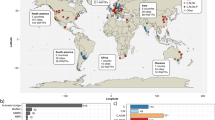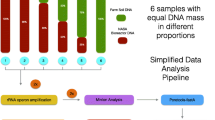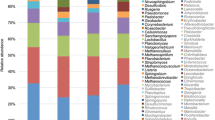Abstract
Molecular approaches aimed at detection of a broad-range of prokaryotes in the environment routinely rely on classifying heterogeneous 16S rRNA genes amplified by polymerase chain reaction (PCR) using primers with broad specificity. The general method of sampling and categorizing DNA has been to clone then sequence the PCR products. However, the number of clones required to adequately catalog the majority of taxa in a sample is unwieldy. Alternatively, hybridizing target sequences to a universal 16S rRNA gene microarray may provide a more rapid and comprehensive view of prokaryotic community composition. This study investigated the breadth and accuracy of a microarray in detecting diverse 16S rRNA gene sequence types compared to clone-and-sequencing using three environmental samples: urban aerosol, subsurface soil, and subsurface water. PCR products generated from universal 16S rRNA gene-targeted primers were classified by using either the clone-and-sequence method or by hybridization to a novel high-density microarray of 297,851 probes complementary to 842 prokaryotic subfamilies. The three clone libraries comprised 1391 high-quality sequences. Approximately 8% of the clones could not be placed into a known subfamily and were considered novel. The microarray results confirmed the majority of clone-detected subfamilies and additionally demonstrated greater amplicon diversity extending into phyla not observed by the cloning method. Sequences matching operational taxonomic units within the phyla Nitrospira, Planctomycetes, and TM7, which were uniquely detected by the array, were verified with specific primers and subsequent amplicon sequencing. Subfamily richness detected by the array corresponded well with nonparametric richness predictions extrapolated from clone libraries except in the water community where clone-based richness predictions were greatly exceeded. It was concluded that although the microarray is unreliable in identifying novel prokaryotic taxa, it reveals greater diversity in environmental samples than sequencing a typically sized clone library. Furthermore, the microarray allowed samples to be rapidly evaluated with replication, a significant advantage in studies of microbial ecology.


Similar content being viewed by others
References
Bach, HJ, Tomanova, J, Schloter, M, Munch, JC (2002) Enumeration of total bacteria and bacteria with genes for proteolytic activity in pure cultures and in environmental samples by quantitative PCR mediated amplification. J Microbiol Methods 49: 235–245
Castiglioni, B, Rizzi, E, Frosini, A, Sivonen, K, Rajaniemi, P, Rantala, A, Mugnai, MA, Ventura, S, Wilmotte, A, Boutte, C, Grubisic, S, Balthasart, P, Consolandi, C, Bordoni, R, Mezzelani, A, Battaglia, C, De Bellis, G (2004) Development of a universal microarray based on the ligation detection reaction and 16S rRNA gene polymorphism to target diversity of cyanobacteria. Appl Environ Microbiol 70: 7161–7172
Chandler, DP, Jarrell, AE (2005) Taking arrays from the lab to the field: trying to make sense of the unknown. BioTechniques 38: 591–600
Chao, A (1984) Non-parametric estimation of the number of classes in a population. Scand J Statist 11: 265–270
Chao, S, Lee, AM (1992) Estimating the number of classes via sample coverage. J Am Stat Assoc 87: 210–217
Chee, M, Yang, R, Hubbell, E, Berno, A, Huang, XC, Stern, D, Winkler, J, Lockhart, DJ, Morris, MS, Fodor, SP (1996) Accessing genetic information with high-density DNA arrays. Science 274: 610–614
Chouari, R, Le Paslier, D, Dauga, C, Daegelen, P, Weissenbach, J, Sghir, A (2005) Novel major bacterial candidate division within a municipal anaerobic sludge digester. Appl Environ Microbiol 71: 2145–2153
Crocetti, GR, Hugenholtz, P, Bond, PL, Schuler, A, Keller, J, Jenkins, D, Blackall, LL (2000) Identification of polyphosphate-accumulating organisms and design of 16S rRNA-directed probes for their detection and quantitation. Appl Environ Microbiol 66: 1175–1182
DeSantis, TZ, Dubosarskiy, I, Murray, SR, Andersen, GL (2003) Comprehensive aligned sequence construction for automated design of effective probes (CASCADE-P) using 16S rDNA. Bioinformatics 19: 1461–1468
DeSantis, TZ, Hugenholtz, P, Keller, K, Brodie, EL, Larsen, N, Piceno, YM, Phan, R, Andersen, GL (2006) NAST: a multiple sequence alignment server for comparative analysis of 16S rRNA genes. Nucleic Acids Res 34: W394–399
DeSantis, TZ, Hugenholtz, P, Larsen, N, Rojas, M, Brodie, EL, Keller, K, Huber, T, Dalevi, D, Hu, P, Andersen, GL (2006) Greengenes, a chimera-checked 16S rRNA genes database and workbench compatible with ARB. Appl Environ Microbiol 72: 5069–5072
DeSantis, TZ, Stone, CE, Murray, SR, Moberg, JP, Andersen, GL (2005) Rapid quantification and taxonomic classification of environmental DNA from both prokaryotic and eukaryotic origins using a microarray. FEMS Microbiol Lett 245: 271–278
Dojka, MA, Hugenholtz, P, Haack, SK, Pace, NR (1998) Microbial diversity in a hydrocarbon- and chlorinated-solvent-contaminated aquifer undergoing intrinsic bioremediation. Appl Environ Microbiol 64: 3869–3877
Dunbar, J, Barns, SM, Ticknor, LO, Kuske, CR (2002) Empirical and theoretical bacterial diversity in four Arizona soils. Appl Environ Microbiol 68: 3035–3045
Elshahed, MS, Senko, JM, Najar, FZ, Kenton, SM, Roe, BA, Dewers, TA, Spear, JR, Krumholz, LR (2003) Bacterial diversity and sulfur cycling in a mesophilic sulfide-rich spring. Appl Environ Microbiol 69: 5609–5621
Ewing, B, Green, P (1998) Base-calling of automated sequencer traces using phred. II. Error probabilities. Genome Res 8: 186–194
Ewing, B, Hillier, L, Wendl, MC, Green, P (1998) Base-calling of automated sequencer traces using phred. I. Accuracy assessment. Genome Res 8: 175–185
Farrelly, V, Rainey, FA, Stackebrandt, E (1995) Effect of genome size and rrn gene copy number on PCR amplification of 16S rRNA genes from a mixture of bacterial species. Appl Environ Microbiol 61: 2798–2801
Felsenstein, J (1989) PHYLIP—Phylogeny Inference Package (Version 3.65). Cladistics 5: 164–166
Felske, A, Akkermans, AD (1998) Prominent occurrence of ribosomes from an uncultured bacterium of the Verrucomicrobiales cluster in grassland soils. Lett Appl Microbiol 26: 219–223
Gans, J, Wolinsky, M, Dunbar, J (2005) Computational improvements reveal great bacterial diversity and high metal toxicity in soil. Science 309: 1387–1390
Garrity, GM (2001) Bergey's Manual of Systematic Bacteriology, 2nd edn. Springer-Verlag, New York
Ginige, MP, Hugenholtz, P, Daims, H, Wagner, M, Keller, J, Blackall, LL (2004) Use of stable-isotope probing, full-cycle rRNA analysis, and fluorescence in situ hybridization-microautoradiography to study a methanol-fed denitrifying microbial community. Appl Environ Microbiol 70: 588–596
Holmes, DE, Finneran, KT, O'Neil, RA, Lovley, DR (2002) Enrichment of members of the family Geobacteraceae associated with stimulation of dissimilatory metal reduction in uranium-contaminated aquifer sediments. Appl Environ Microbiol 68: 2300–2306
Huber, T, Faulkner, G, Hugenholtz, P (2004) Bellerophon: a program to detect chimeric sequences in multiple sequence alignments. Bioinformatics 20: 2317–2319
Hugenholtz, P (2002) Exploring prokaryotic diversity in the genomic era. Genome Biol 3: 1–8
Hugenholtz, P, Goebel, BM, Pace, NR (1998) Impact of culture-independent studies on the emerging phylogenetic view of bacterial diversity. J Bacteriol 180: 4765–4774
Hugenholtz, P, Huber, T (2003) Chimeric 16S rDNA sequences of diverse origin are accumulating in the public databases. Int J Syst Evol Microbiol 53: 289–293
Hugenholtz, P, Tyson, GW, Webb, RI, Wagner, AM, Blackall, LL (2001) Investigation of candidate division TM7, a recently recognized major lineage of the domain Bacteria with no known pure-culture representatives. Appl Environ Microbiol 67: 411–419
Hughes, JB, Hellmann, JJ, Ricketts, TH, Bohannan, BJ (2001) Counting the uncountable: statistical approaches to estimating microbial diversity. Appl Environ Microbiol 67: 4399–4406
Junca, H, Pieper, DH (2004) Functional gene diversity analysis in BTEX contaminated soils by means of PCR-SSCP DNA fingerprinting: comparative diversity assessment against bacterial isolates and PCR-DNA clone libraries. Environ Microbiol 6: 95–110
Kazor, CE, Mitchell, PM, Lee, AM, Stokes, LN, Loesche, WJ, Dewhirst, FE, Paster, BJ (2003) Diversity of bacterial populations on the tongue dorsa of patients with halitosis and healthy patients. J Clin Microbiol 41: 558–563
Kelly, JJ, Siripong, S, McCormack, J, Janus, LR, Urakawa, H, El Fantroussi, S, Noble, PA, Sappelsa, L, Rittmann, BE, Stahl, DA (2005) DNA microarray detection of nitrifying bacterial 16S rRNA in wastewater treatment plant samples. Water Res 39: 3229–3238
Kent, AD, Smith, DJ, Benson, BJ, Triplett, EW (2003) Web-based phylogenetic assignment tool for analysis of terminal restriction fragment length polymorphism profiles of microbial communities. Appl Environ Microbiol 69: 6768–6776
Lane, DJ (1991) Nucleic acid techniques in bacterial systematics. In: Stackebrandt, E, Goodfellow, M (Eds.) Nucleic Acid Techniques in Bacterial Systematics, Vol 1. Wiley, New York, pp 115–175
Lanser, JA, Adams, M, Doyle, R, Sangster, N, Steele, TW (1990) Genetic relatedness of Legionella longbeachae isolates from human and environmental sources in Australia. Appl Environ Microbiol 56: 2784–2790
Lehner, A, Loy, A, Behr, T, Gaenge, H, Ludwig, W, Wagner, M, Schleifer, KH (2005) Oligonucleotide microarray for identification of Enterococcus species. FEMS Microbiol Lett 246: 133–142
Lindstrom, UM, Kool, ET (2002) An orthogonal oligonucleotide protecting group strategy that enables assembly of repetitive or highly structured DNAs. Nucleic Acids Res 30: e101
Liu, WT, Stahl, DA (2002) Molecular approaches for the measurement of density, diversity, and phylogeny. In: Hurst, CJ, Crawford, RL, Knudsen, GR, McInerney, MJ, Stetzenbach, LD (Eds.) Manual of Environmental Microbiology, 2nd edn., pp 114–134
Loy, A, Lehner, A, Lee, N, Adamczyk, J, Meier, H, Ernst, J, Schleifer, KH, Wagner, M (2002) Oligonucleotide microarray for 16S rRNA gene-based detection of all recognized lineages of sulfate-reducing prokaryotes in the environment. Appl Environ Microbiol 68: 5064–5081
Ludwig, W, Strunk, O, Westram, R, Richter, L, Meier, H, Yadhukumar, Buchner, A, Lai, T, Steppi, S, Jobb, G, Forster, W, Brettske, I, Gerber, S, Ginhart, AW, Gross, O, Grumann, S, Hermann, S, Jost, R, Konig, A, Liss, T, Lussmann, R, May, M, Nonhoff, B, Reichel, B, Strehlow, R, Stamatakis, A, Stuckmann, N, Vilbig, A, Lenke, M, Ludwig, T, Bode, A, Schleifer, KH (2004) ARB: a software environment for sequence data. Nucleic Acids Res 32: 1363–1371
Lueders, T, Friedrich, M (2000) Archaeal population dynamics during sequential reduction processes in rice field soil. Appl Environ Microbiol 66: 2732–2742
Magurran, AE (1988) Ecological Diversity and Its Measurement. Princeton University Press, Princeton, NJ
Masuda, N, Church, GM (2002) Escherichia coli gene expression responsive to levels of the response regulator EvgA. J Bacteriol 184: 6225–6234
McCaig, AE, Glover, LA, Prosser, JI (1999) Molecular analysis of bacterial community structure and diversity in unimproved and improved upland grass pastures. Appl Environ Microbiol 65: 1721–1730
Miller, DN, Bryant, JE, Madsen, EL, Ghiorse, WC (1999) Evaluation and optimization of DNA extraction and purification procedures for soil and sediment samples. Appl Environ Microbiol 65: 4715–4724
Ohara, O, Temple, G (2001) Directional cDNA library construction assisted by the in vitro recombination reaction. Nucleic Acids Res 29: E22
Polz, MF, Cavanaugh, CM (1998) Bias in template-to-product ratios in multitemplate PCR. Appl Environ Microbiol 64: 3724–3730
Rosch, C, Bothe, H (2005) Improved assessment of denitrifying, N2-fixing, and total-community bacteria by terminal restriction fragment length polymorphism analysis using multiple restriction enzymes. Appl Environ Microbiol 71: 2026–2035
Rozen, S, Skaletsky, H (2000) Primer3 on the WWW for general users and for biologist programmers. Methods Mol Biol 132: 365–386
Schloss, PD, Handelsman, J (2005) Introducing DOTUR, a computer program for defining operational taxonomic units and estimating species richness. Appl Environ Microbiol 71: 1501–1506
Schloss, PD, Handelsman, J (2004) Status of the microbial census. Microbiol Mol Biol Rev 68: 686–691
Schmidt, TM, DeLong, EF, Pace, NR (1991) Analysis of a marine picoplankton community by 16S rRNA gene cloning and sequencing. J Bacteriol 173: 4371–4378
Skowronski, EW, Armstrong, N, Andersen, G, Macht, M, McCready, PM (2000) Magnetic, microplate-format plasmid isolation protocol for high-yield, sequencing-grade DNA. BioTechniques 29: 786–788, 790, 792
Torsvik, V, Daae, FL, Sandaa, RA, Ovreas, L (1998) Novel techniques for analysing microbial diversity in natural and perturbed environments. J Biotechnol 64: 53–62
Urakawa, H, Noble, PA, El Fantroussi, S, Kelly, JJ, Stahl, DA (2002) Single-base-pair discrimination of terminal mismatches by using oligonucleotide microarrays and neural network analyses. Appl Environ Microbiol 68: 235–244
Wan, J, Tokunaga, TK, Brodie, E, Wang, Z, Zheng, Z, Herman, D, Hazen, TC, Firestone, MK, Sutton, SR (2005) Reoxidation of bioreduced uranium under reducing conditions. Environ Sci Technol 39: 6162–6169
Warsen, AE, Krug, MJ, LaFrentz, S, Stanek, DR, Loge, FJ, Call, DR (2004) Simultaneous discrimination between 15 fish pathogens by using 16S ribosomal DNA PCR and DNA microarrays. Appl Environ Microbiol 70: 4216–4221
Webster, G, Newberry, CJ, Fry, JC, Weightman, AJ (2003) Assessment of bacterial community structure in the deep sub-seafloor biosphere by 16S rDNA-based techniques: a cautionary tale. J Microbiol Methods 55: 155–164
Wilson, KH, Blitchington, RB, Greene, RC (1990) Amplification of bacterial 16S ribosomal DNA with polymerase chain reaction [published erratum appears in J Clin Microbiol 1991 Mar; 29(3): 666]. J Clin Microbiol 28: 1942–1946
Wilson, KH, Wilson, WJ, Radosevich, JL, DeSantis, TZ, Viswanathan, VS, Kuczmarski, TA, Andersen, GL (2002) High-density microarray of small-subunit ribosomal DNA probes. Appl Environ Microbiol 68: 2535–2541
Wilson, WJ, Strout, CL, DeSantis, TZ, Stilwell, JL, Carrano, AV, Andersen, GL (2002) Sequence-specific identification of 18 pathogenic microorganisms using microarray technology. Mol Cell Probes 16: 119–127
Wu, L, Thompson, DK, Li, G, Hurt, RA, Tiedje, JM, Zhou, J (2001) Development and evaluation of functional gene arrays for detection of selected genes in the environment. Appl Environ Microbiol 67: 5780–5790
Zhou, J (2003) Microarrays for bacterial detection and microbial community analysis. Curr Opin Microbiol 6: 288–294
Acknowledgments
The authors wish to thank Dr. Phil Hugenholtz and Dr. Paul Richardson of the Joint Genome Institute for assistance in constructing the clone libraries. We acknowledge the expert technical assistance of Sonya Murray, Richard Phan, Mark Rojas, and Ramine Cromartie-Thornton. Computational support was provided through the Virtual Institute for Microbial Stress and Survival (http://VIMSS.lbl.gov). This work was performed under the auspices of the US Department of Energy by the University of California, Lawrence Berkeley National Laboratory under Contract No. DE-AC02-05CH11231, and was funded in part by the Department of Homeland Security under grant number HSSCHQ04X00037 and in part by the Department of Energy, Environmental Remediation Sciences Program (ERSP) and the Genomics: GTL program.
Author information
Authors and Affiliations
Corresponding author
Rights and permissions
About this article
Cite this article
DeSantis, T.Z., Brodie, E.L., Moberg, J.P. et al. High-Density Universal 16S rRNA Microarray Analysis Reveals Broader Diversity than Typical Clone Library When Sampling the Environment. Microb Ecol 53, 371–383 (2007). https://doi.org/10.1007/s00248-006-9134-9
Received:
Accepted:
Published:
Issue Date:
DOI: https://doi.org/10.1007/s00248-006-9134-9




